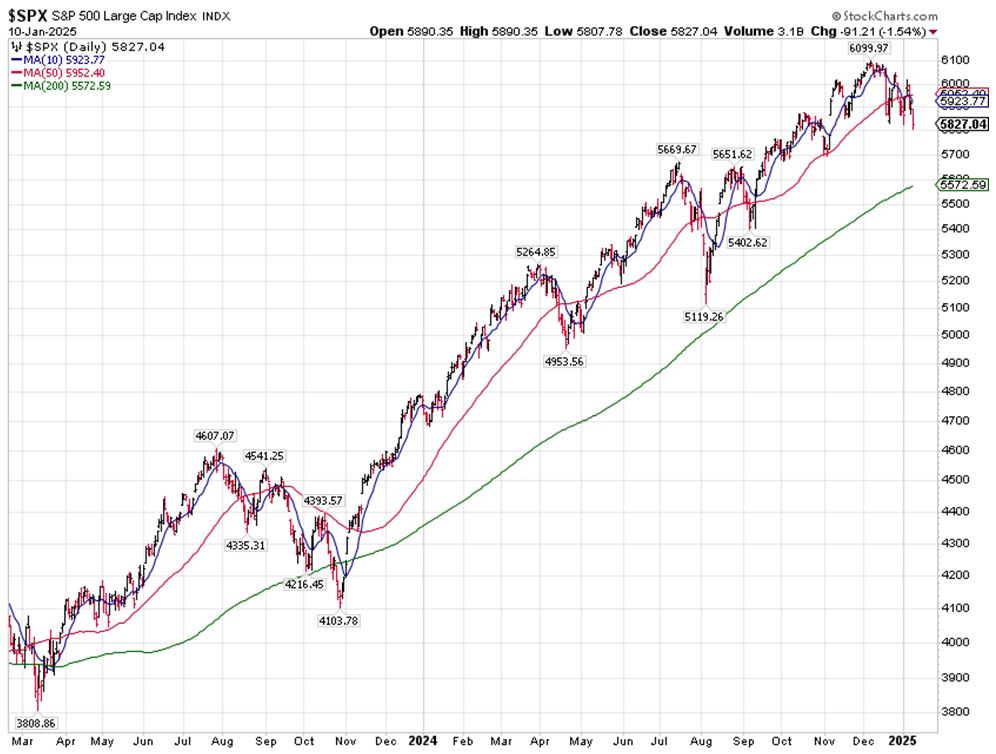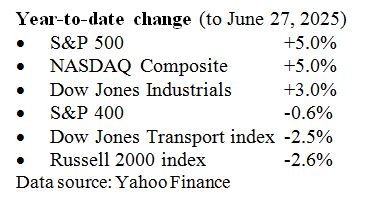by Ivan Martchev
January 14, 2025
Treasury yields have gone straight up since Scott Bessent was nominated for Treasury Secretary, rising 65 basis points since the lows on December 6th. It’s not surprising that the stock market more or less topped out right near that low in the 10-year yield at 4.126% and has more or less meandered lower since then.
The reason for the sell-off in bonds is that the economy is too strong and, as a result, the projected number of 2025 Fed rate cuts is lower. In other words, good news is bad news when it comes to stocks and bonds.
How far could Treasury yields go up?
Graphs are for illustrative and discussion purposes only. Please read important disclosures at the end of this commentary.
Last week took us above the 2024 highs of 4.74%. The highs for 2023 are just below 5% (at 4.997%). The way the bond market is moving, this can happen in a week. I think the Treasury yield has risen too far too fast, but with this type of momentum and with the right type of fuel on the fire (good economic data), it can move a little farther. A hawkish Powell in his upcoming FOMC press conference can push rates to 5% in one day, although it has to be remembered that Jerome Powell is a flip-flopper when it comes to his FOMC language and he may flip flop one more time, given how much the bond market has moved.
Graphs are for illustrative and discussion purposes only. Please read important disclosures at the end of this commentary.
If Jerome Powell doesn’t flip flop yet again, and we see 5% on the 10-year Treasury yield, the S&P 500 is likely headed to its 200-day moving average, which stands at 5572 now and may be near 5600 soon.
We didn’t touch the 200-day moving average in 2024, which reflects a strong rally year, but we are due to touch it in 2025, and now looks like a good time, with surging bond yields and investors hyperventilating over the overzealous Trump policy agenda, since he won’t run for President again, and his approach may be even more blunt this time, given that he feels he has some unfinished business from his first term.
Several investors have asked me if they should sell stocks because Trump is President, and my answer is that his first administration was a great time to be in stocks. I do expect a blunter approach from Trump and higher volatility as a result in both stocks and bonds, but I don’t think he is out to ruin the economy.
Another clue that we may be headed for the 200-day moving average in the S&P 500 is the persistent negative breadth reading, which began in early December. To make matters worse, the stock market is weak when it should be seasonally strong (December and January), although January is far from over.
One old timer who has been in the trenches of the stock market much longer than I have been told me many years ago about a reliable red flag when it comes to sell-offs. It is a credible warning to look for more weakness if the stock market takes out the December low in January, which, when it comes to the S&P 500, happened last Friday on the news of the good jobs report. It has to do with the fact that stocks are not acting well in a seasonally strong part of the year when new money should be coming into the market and stocks are beginning to trend lower. The stock market is not doing what it is supposed to do.
However, before we extrapolate a bigger decline, let’s keep in mind that the area around a rising 200-day moving average is also a great support level, particularly if the stock market has spent a long time above that line. Bear markets are extremely rare in an economy without a recession. In such cases, they tend to reverse quickly, as they are typically driven by external factors that have nothing to do with a good economy, which we currently have. This is the main reason why I think this is just a correction.
The post 1-14-25: Treasuries are the Biggest Problem Facing Stocks Now appeared first on Navellier.








